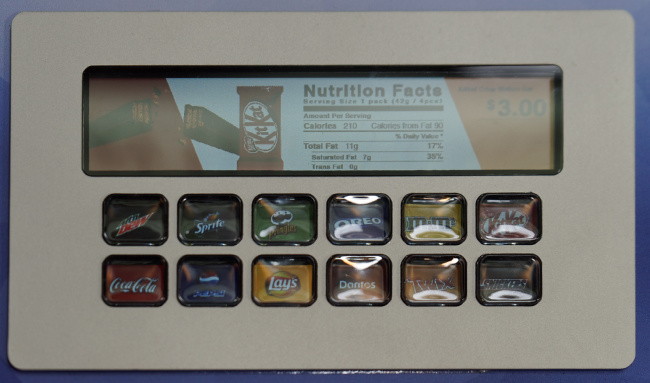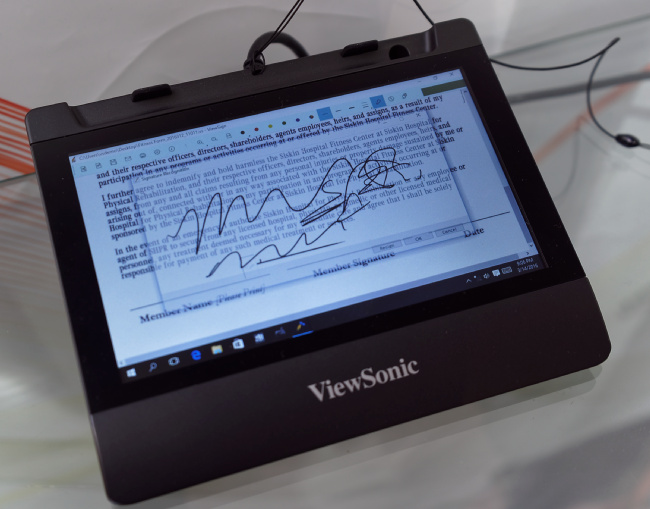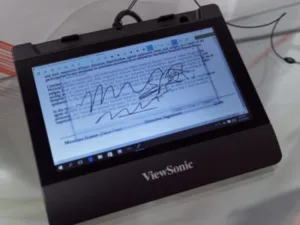Huawei was keen to make an impression and had a big booth highlighting its capabilities in communications. We spotted a demonstration of an ip camera that supports the H.265 codec that was running 1080P at just 1Mbps, compared to an H.264 version that was running at 4Mbps. The signage (and staff) indicated that the image quality was “the same”. Well, not to our eyes! The H.265 version had a lot more obvious blocking and other artefacts. However, we had to agree that the small text on each was at a comparable level of legibility.
Infinitton is from Taiwan and was showing a number of switch designs where a transparent switch array covers an LCD. By changing the content on the display, the switches become graphically programmed. 2.8″, 4.3″ and 7.0″ displays can be supported and the smaller sizes can act as individual large switches.. The technology supports Windows from Windows 7 and Macs from OSX V10.9
 This Infinitton LCD backed switch makes each switch graphically programmable. Image:Meko
This Infinitton LCD backed switch makes each switch graphically programmable. Image:Meko
Intel had quite a big booth in Halle 3, but most of it was taken up with meeting space. There was lots about IoT, including vineyard monitoring technology, but the only demo that was in our area was a small area devoted to a demonstration of wireless docking using docs from Lenovo, HP and Dell.
At the Retail Digital Signage Expo in London last week, we met with SES-Imagotag and at CeBIT we talked to Lancom, which supplies the Wi-fi access points and systems that work with the SES system. Lancom, which is a Wi-fi and networking specialist, also supplies a range of larger E Ink-based displays that it sells mainly for applications such as room signage. Lancom highlighted to us that the controller for the labels could also be used to track customers and provide access for them as well as providing beacon support.
 Lancom works with Imagotag labels or its own room displays. Image:Meko
Lancom works with Imagotag labels or its own room displays. Image:Meko
Microsoft was highlighting the Surface products including the Hub (although there was only one) and its tablets and convertibles, as well as partner systems. The Surface products were getting some attention, especially the Surface Book, which with its high performance and slim weight (and integrated GPU) looks very desirable. However the highest specification device (with Nvidia GPU, 512GB, 16GB and a corei7 processor) costs €3,000, €1,000 more than the one with 256GB/8GB and corei5! The 3000 x 2000 resolution (13.5″) display looks really good although we could only try it at the show on apps such as the latest Excel which works well in this high resolution.
Sky Devices, which claims to be the fastest growing smartphone maker “in its category” in the US and was showing three series of phones with ten new models. The Fuego series is for entry level buyers upgrading from a feature phone, the Platinum series is aimed at the mainstream and the Elite series is intended for demanding consumers. Unusually, the company is offering a 24 month warranty – a bold move for a smartphone maker.
We met up with ViewSonic Hanvon which is a company that was set up in June 2013 (Display Monitor Vol 18 #21) with some capital from Hanvon (at one point the largest supplier of eReaders in China) to develop products using pen technology that was developed by Hanvon, but was not being exploited by the firm. We reported on the technology in our SID 2011 report.
The joint venture company is selling under the ViewSonic brand and was showing 7″, 10.1″, 15.6″ and 21.5″ monitors and tablets that use the Hanvon pen digitiser technology. Vertical markets being developed include banking, medical, hospitality, education and retail. The monitors use DisplayLink USB technology to connect and we tested the pen response. It was dramatically better than the kind of pad we are usually presented with to sign for received parcels!
 Viewsonic Hanvon’s pen tablet was very accurate and responsive. Image:Meko
Viewsonic Hanvon’s pen tablet was very accurate and responsive. Image:Meko

